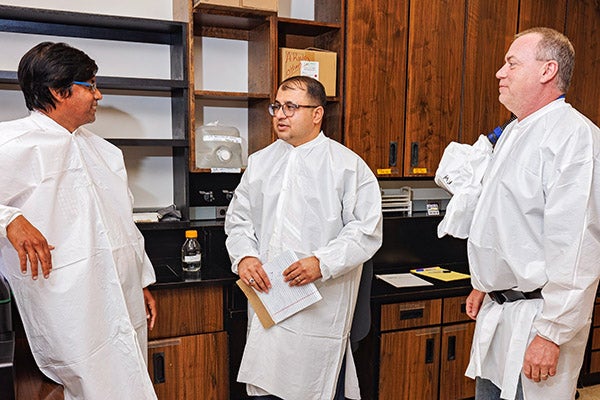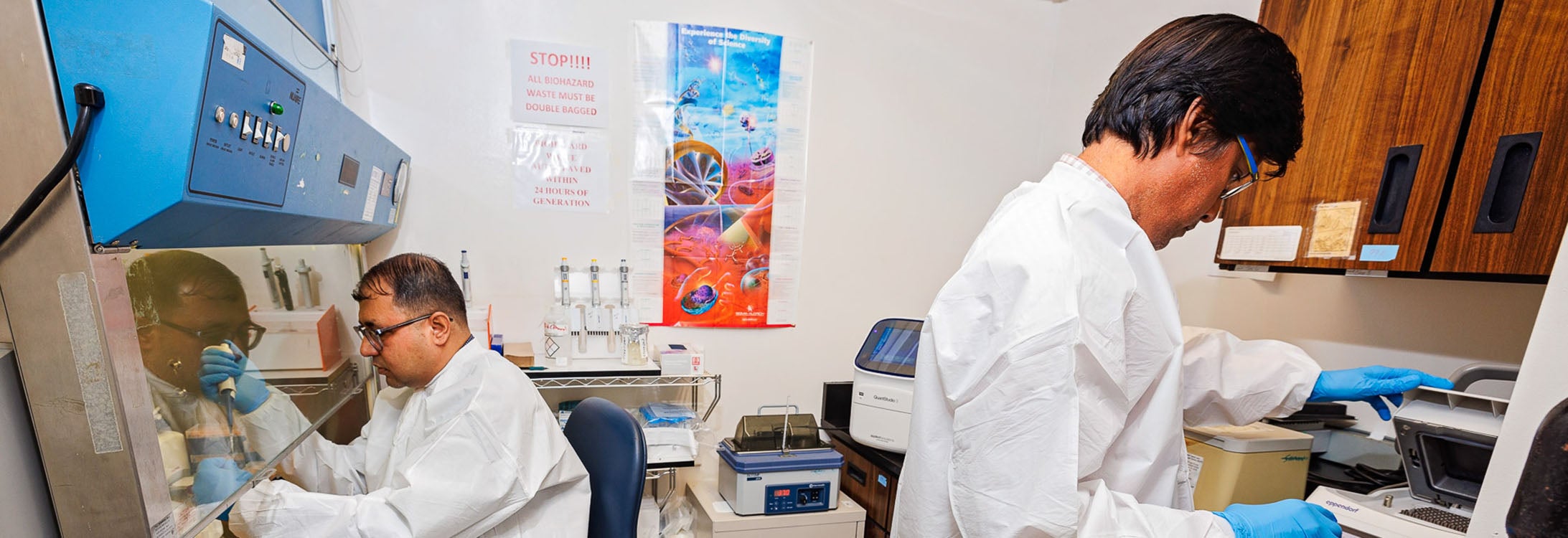FIGHTING COVID-19
ECU researcher’s patented technology could provide new treatment
A pair of researchers at East Carolina University’s Brody School of Medicine have discovered that a new nanotechnology could potentially have therapeutic benefits in the treatment of SARS-CoV-2, the virus that causes COVID-19.
Dr. Lok Pokhrel, an assistant professor of toxicology in Brody’s Department of Public Health, received a patent through the U.S. Patent and Trademark Office in June 2020 for outlining how an antiviral nano-drug that he designed and developed — called SNAT (Smart Nano-Enabled Antiviral Therapeutic) — could serve as an intranasal antiviral agent against SARS-CoV-2.
“In the beginning of the pandemic there were no vaccines, but I had this technology that we found to have antimicrobial properties and I wanted to see if it would also work on viruses,” Pokhrel said.
“So I needed to find a virologist to collaborate with and to explore if the drug works and if it does work, how it works.”
In response to the pandemic, ECU constructed a pair of Biosafety Level 3 laboratories (BSL3) to allow scientists to safely study toxins or infectious agents, such as SARS-CoV-2. This enabled Pokhrel to partner with Dr. Shaw Akula, a virologist and associate professor in Brody’s Department of Microbiology and Immunology, to conduct preclinical research into the potential therapeutic benefits of this novel technology against SARS-CoV-2.
“We tested the ability of this nanoparticle to inhibit SARS-CoV-2 and it not only lowered the SARS-CoV-2 levels, but it also improved lung health and significantly reduced the body weight loss due to viral infections,” Akula said.
When the world turned to scientists for a solution to COVID-19, Akula said he and Pokhrel were eager to use their expertise to try to gain a better understanding of the virus; the patented nanotechnology provided an exciting path toward potential clinical implementation.

Researchers at East Carolina University’s Brody School of Medicine have discovered that a new nanotechnology could potentially have therapeutic benefits in the treatment of SARS-CoV-2, the virus that causes COVID-19.
“As a virologist, I am excited for any challenge, because I am very comfortable handling any virus,” said Akula, who grows the SAR-CoV-2 virus in his ECU lab. “But this (Pokhrel’s) invention is an amazing product, so I am grateful that he brought me into this work. Because we are looking at benefits beyond just this particular virus. All the credit goes to Dr. Pokhrel to have designed and developed SNAT.”
Even though the researchers were able to show the drug is effective and shows a high efficiency in the treatment of SARS-CoV-2, Pokhrel explained that research and work related to the nanotechnology is still ongoing, including working to better understand the mechanisms of how and why it is effective.
And while the drug still needs to go through the clinical trial process before it can be administered intranasally as a treatment to humans, the potential benefits extend beyond its efficiency against SARS-CoV-2.
“Our technology is stable for over three years at room temperature, so it does not require refrigeration for storage or transportation. This is very important because it saves a lot of resources, especially in areas where there is poor infrastructure,” Pokhrel said. “And this could also, perhaps, be a platform technology for the future. When there is any new pandemic, we could modify the surface of the particle the way we want and then test on any new viruses in the future.”
